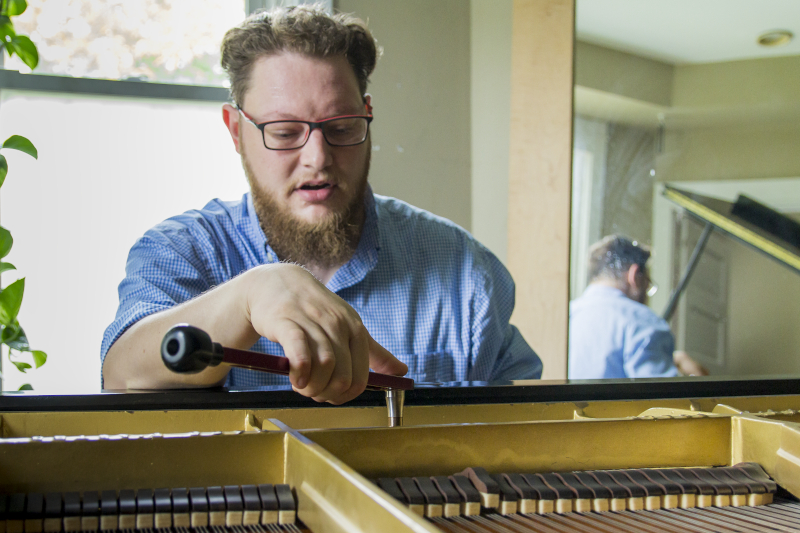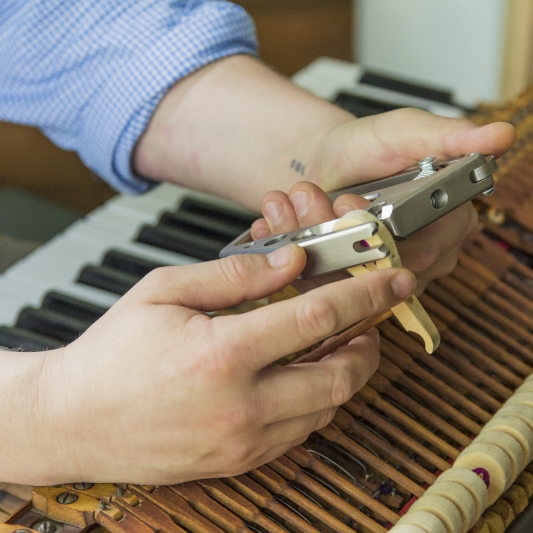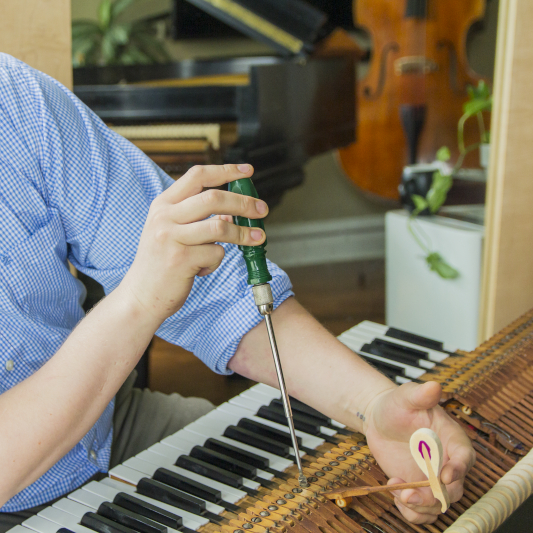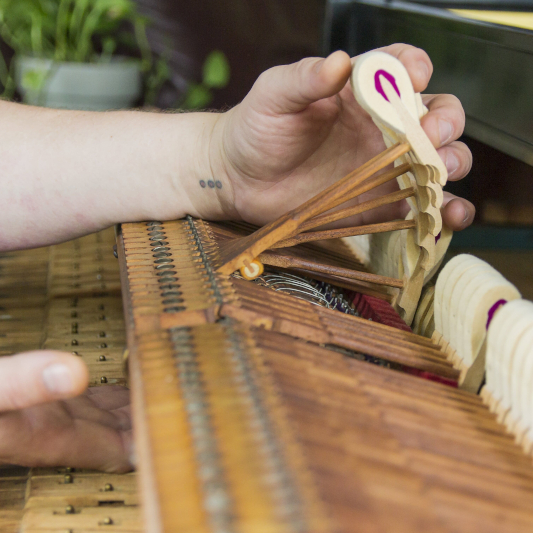Or, if you are looking for Piano Teachers, Piano Movers, Electric and Digital Piano Repair, or Player Piano Repair, please follow this link for my best recommendations of other local professionals.
Tuning
Why does a piano go out of tune?
In short, because of the weather.
Your piano is made largely of wood, and wood is a material constantly in flux. Wood changes dimension when the temperature and especially when the humidity in the surrounding environment changes. You may have experienced a wooden door frame swelling and the door sticking shut because of increased humidity in summertime; this is because wood absorbs and desorbs moisture according to the air surrounding it. The piano’s soundboard (the panel in the piano that transmits the energy from the strings into the air similar to a stereo speaker) is very sensitive to these humidity changes. It swells in humid summer months and because it is in contact with the strings the soundboard introduces extra pressure into the system, subsequently making the pitch go up. The opposite happens in the winter; the soundboard shrinks and the pitch goes down. It just so happens that the piano usually doesn’t recover as strongly to the downswing in pitch from the dry winter months, so the overall net effect of the seasonal change is typically a drop in pitch over time.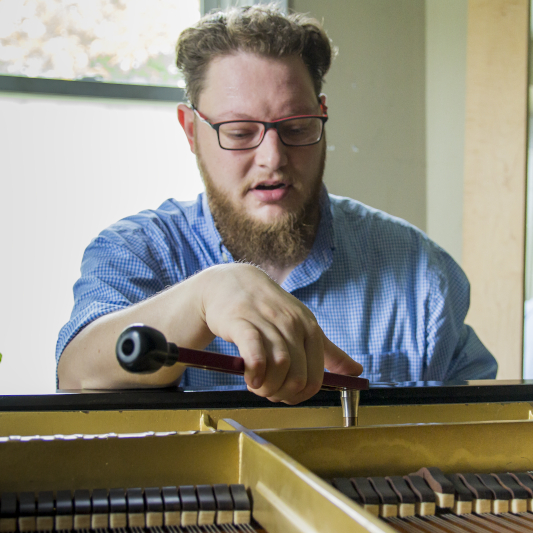 Pianos are designed to be tuned so that the A above middle C is vibrating at 440 cycles per second. This is an international standard for orchestras and musical instruments in general; the standard is also called ‘concert pitch’. It’s important to keep a piano tuned at concert pitch for a few reasons:
Pianos are designed to be tuned so that the A above middle C is vibrating at 440 cycles per second. This is an international standard for orchestras and musical instruments in general; the standard is also called ‘concert pitch’. It’s important to keep a piano tuned at concert pitch for a few reasons:
- The instrument will match in pitch with other instruments for ensemble playing.
- A musician’s ear is always evolving; this is especially the case with young children. People need an accurate reference for ear training and an piano at correct pitch ensures this.
- With the pitch at A-440 the tensions and structures of the piano are at equilibrium for which it was designed which encourages tuning stability over time and insures that the instrument is in a state of optimal maintenance.
- Last but not least, the piano will have the most power and the most beautiful tone at the pitch in which the factory intended.
Whew. Well, all this just begs the question…
How often does a piano need to be tuned?
Most manufacturers recommend that a piano should be tuned four times in its first year after being delivered from the factory due to strings stretching and other internal parts coming to an equilibrium state under the enormous tensions of the strings.
After this first year, the manufacturers recommend having a piano tuned twice per year (remember those seasonal humidity changes?), depending on the frequency of use and demands of the playing conditions.
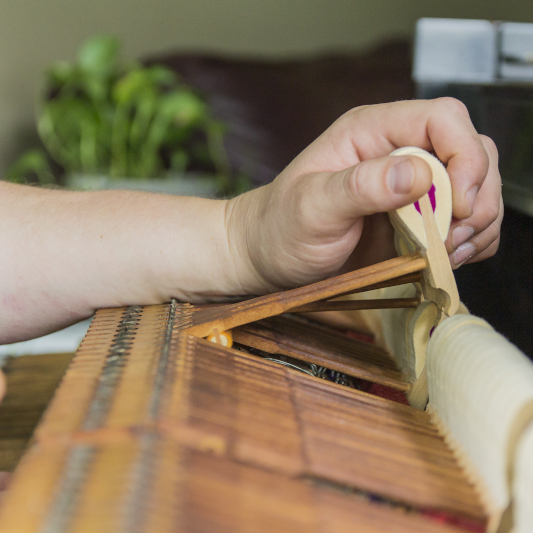 Why would my piano need a pitch correction? And, what does this have to do with my shoes?!
Why would my piano need a pitch correction? And, what does this have to do with my shoes?!
If a piano’s pitch has deviated considerably from concert pitch at A-440, it could require a pitch correction. When the pitch drops a significant amount, the amount of over tension of the strings is decreased. It’s impossible to add a lot of tension at once and have the piano stay at a stable pitch because of what I call the “shoelace effect”.
If your shoelaces were very loose and you just tugged strongly at the ends of the laces, the top segments of the laces would be tight and the segments closer to your toes would have more slack. As you walked around over the day, the tension in these segments would equalize a bit more but still be looser than you intended when you tied your shoes. Instead what we do is pull the lower segments a little bit, then the middle ones, then the top segments; this creates stability and you know that your shoes will stay at the higher tension you intended them to be in the first place.
This is analogous to what I am doing to a piano when I do a pitch correction. I bring the piano close to pitch just as you would add tension from the bottom to the top when tightening a shoe. Then, once the average pitch of the piano is in the right range and the overall tension of the strings are correct, I can apply a complete tuning that will remain stable over time.Regulation
What does it mean to regulate a piano?
In piano lingo, “regulation” is synonymous with “optimization” and “adjustment”. Depending on the style and manufacturer, a piano has close to fifty individual parts per note. Take a few seconds to look below at the cross section of a single key from a grand or a vertical piano. Now stack 88 of these right next to each other — that’s a lot of intricate parts! At first glance, it looks like a Rube Goldberg contraption, or the old board game ‘Mousetrap’. Each of these parts you see has a specific individual function and requires an individualized adjustment. Due to the nature of their small size and the demanding requirements of having to produce a beautiful musical tone when played at the extremes of loudness and softness, the parts inside the piano need to be adjusted to incredibly small tolerances (often measured in thousands of an inch).
For the same reason a piano goes out of tune, a piano occasionally requires minor or major adjustment due to the changes in humidity that swell and shrink wooden parts. Also, the cumulative effects of playing on the instrument over time cause wear and tear. Just like your car needs periodic maintenance to adjust the timing belt and replace fluids, filters, and brake pads that wear, your piano needs occasional attention to the parts that are worn and out of adjustment from regular usage.
Now stack 88 of these right next to each other — that’s a lot of intricate parts! At first glance, it looks like a Rube Goldberg contraption, or the old board game ‘Mousetrap’. Each of these parts you see has a specific individual function and requires an individualized adjustment. Due to the nature of their small size and the demanding requirements of having to produce a beautiful musical tone when played at the extremes of loudness and softness, the parts inside the piano need to be adjusted to incredibly small tolerances (often measured in thousands of an inch).
For the same reason a piano goes out of tune, a piano occasionally requires minor or major adjustment due to the changes in humidity that swell and shrink wooden parts. Also, the cumulative effects of playing on the instrument over time cause wear and tear. Just like your car needs periodic maintenance to adjust the timing belt and replace fluids, filters, and brake pads that wear, your piano needs occasional attention to the parts that are worn and out of adjustment from regular usage.
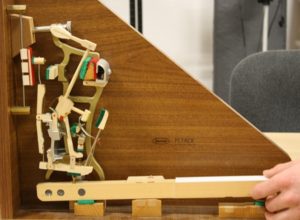 Really though, what benefit does regulating a piano bring?
Really though, what benefit does regulating a piano bring?
Sometimes a piano has a feel that is too heavy or light to the touch. Perhaps the dynamic range isn’t what it used to be; it’s harder to play soft music in a controlled manner or maybe it just doesn’t have the power it used to have. Maybe one note or one section of the keyboard has a different feel than the rest. All of these are signs that a piano needs adjustment.
The goal of regulation is to create evenness of tone, touch, and power from one note to the next and to make the piano transfer energy from the player’s finger to the string in an efficient and completely controllable manner. It is so satisfying to play on an instrument that is in a beautifully balanced state of adjustment. One fine piano player wrote about his experience with a very well regulated piano:
“The instrument feels effortless to play. It feels so good that I can just forget about it – the music just flows out of my fingers and right through the piano without any resistance.”One of the most satisfying things I do on a day to day basis is to regulate pianos to a high level of precision. The results can be amazing, and I love the feeling of walking away from a piano knowing I have incrementally increased an instrument’s capacity to be responsive to the player.
Voicing
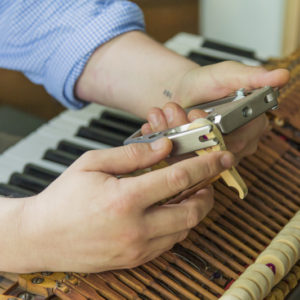 The term “voicing” refers to adjusting the piano’s tonal properties. The tone of an instrument can be modified within certain boundaries to create the sound that the pianist desires. Some prefer a brighter, more confident tone. Some like mellow and subtle. Each player has a different idea of what his or her ideal piano tone might be, and every person has a different “language” to describe what they hear or want to hear from the instrument.
The term “voicing” refers to adjusting the piano’s tonal properties. The tone of an instrument can be modified within certain boundaries to create the sound that the pianist desires. Some prefer a brighter, more confident tone. Some like mellow and subtle. Each player has a different idea of what his or her ideal piano tone might be, and every person has a different “language” to describe what they hear or want to hear from the instrument.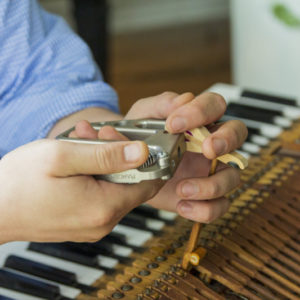 With my clients, it’s my job to establish a common “sound language” so as to best communicate what the piano sounds like currently and what the goals of tone modification will be. If you are interested in optimizing the tone of your piano, the Piano Technicians Guild has a very good article for a little more on the basics of voicing.
With my clients, it’s my job to establish a common “sound language” so as to best communicate what the piano sounds like currently and what the goals of tone modification will be. If you are interested in optimizing the tone of your piano, the Piano Technicians Guild has a very good article for a little more on the basics of voicing.
Repairs
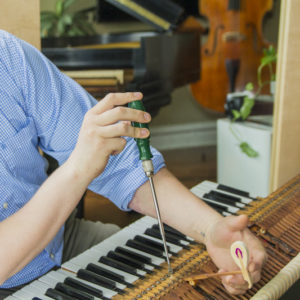 Pianos are usually around for a long time and subject to a lot of love, attention and maybe some neglect and absent-mindedness. If something breaks or just doesn’t function like it used to, I am experienced and qualified to handle the gamut of piano repair issues. Perhaps a key isn’t playing or is “sticking”. Maybe the instrument has a buzz, squeak, creak, or click coming from inside. Possibly the pedals are out of adjustment and don’t function correctly. Maybe a string is rusty, broken, or missing entirely. I can help; give me a call or send me an email.
Pianos are usually around for a long time and subject to a lot of love, attention and maybe some neglect and absent-mindedness. If something breaks or just doesn’t function like it used to, I am experienced and qualified to handle the gamut of piano repair issues. Perhaps a key isn’t playing or is “sticking”. Maybe the instrument has a buzz, squeak, creak, or click coming from inside. Possibly the pedals are out of adjustment and don’t function correctly. Maybe a string is rusty, broken, or missing entirely. I can help; give me a call or send me an email.
Cleaning
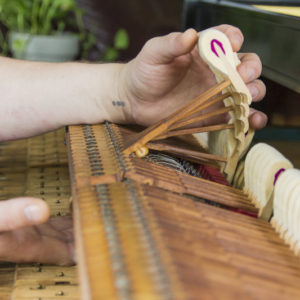 Deep cleaning gets all the dust out, and believe me, pianos catch a lot of dust. Ever wondered how to get the dog hair tumbleweeds out from under the strings on your grand? Let me take care of it for you.
Deep cleaning gets all the dust out, and believe me, pianos catch a lot of dust. Ever wondered how to get the dog hair tumbleweeds out from under the strings on your grand? Let me take care of it for you.
Piano Evaluation
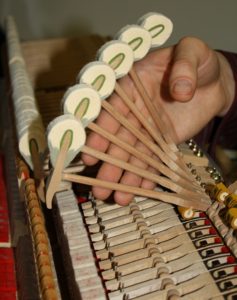 Have you found the potential piano of your dreams but wanted someone with experience to look at it and make sure its up to snuff? I very much enjoy helping folks in the process by providing point-by-point evaluation of all the piano’s systems.
Have you found the potential piano of your dreams but wanted someone with experience to look at it and make sure its up to snuff? I very much enjoy helping folks in the process by providing point-by-point evaluation of all the piano’s systems.
Services I don’t provide:
The Best Piano Professionals I’ve found
in Chicago and the Near Suburbs
- Christopher Narloch – Lessons via Zoom and (in non Covid times) in-person at storefront 4636 N. Francisco Ave. studio.
- Brendan O’Connell – Lessons via Zoom and (in non Covid times) in-home and at-school instruction.
- Alyson Novesky – Lessons via Zoom and (in non Covid times) in person lessons.
- Jonathan Chapman Cook – Lessons via Zoom and (in non Covid times) in-person at storefront 4641 N. Paulina St. Studio
- Quality Piano Moving – Moves pianos locally within Chicago suburban area as well as nationally. Call (773) 455-6956.
- Chicago Electric Piano Company – For Fender Rhodes and Wurlitzer Repairs, Parts and Accessories
- Borish Electronics – Synthesizer and Keyboard Repair
- Deltronics – Digital Piano, Keyboard and Pro Audio Repair
- Wayne Boska – This is THE BEST technician for old-style pneumatic player pianos in the Chicago metro area. Call (773) 518-0938 or email tunerwayne@gmail.com
- Kurt Eckwall – Pianodisc installation, maintenance and repair
- Adam Przybyla – Trained Steinway SPIRIO and SPIRIO-R player piano system technician.

